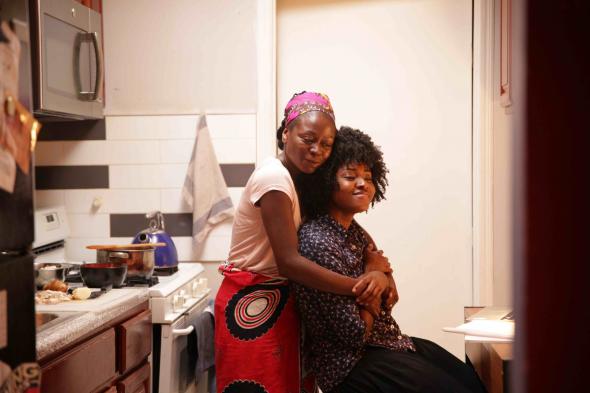A hug that listens
Tanzanian-American filmmaker Ekwa Msangi uses one Angolan family’s story of immigration to tell a larger story.
 A still from 'Farewell Amor.'
A still from 'Farewell Amor.'
The foreground, backlit and moving slowly, announces an airport arrivals terminal; its sounds, and images so recognizable for those leaving one place and arriving in another. The micro-space of airport arrivals and departures depicted in the film Farewell Amor is the perfect representation of the “liquidity of the world” that Zigmund Bauman spoke of—an uncertain and unpredictable world, with constant leaving, constant arriving.
Angola’s recent history is one of wars and dislocations. After 14 years of an anti-colonial war against the Estado Novo regime in Portugal, Angola fell into a civil war from 1975-2002. That war slowed entry to the train of the future: peace arrived with the Luena Accords in 2002. Those who escaped the war, leaving the country before the peace, became antennas of a world in constant movement. Many of those Angolans took what was easy to carry—dance, music, and various kinds of spirituality. The Angolan diaspora glued together utopias and futures until the fighting stopped. The slow consolidation of democracy continues to put off the healing of the wounds left by that past.
The Angolan presence in diaspora is distributed unevenly and thinly around the world with no reliable data to make it visible. The civil war caused waves of migration during the 1980s and 1990s. European cities like Rotterdam, Paris, and Lisbon have sizeable Angolan communities. In the US, Houston has a strong community linked to the oil industry. The size of the Angolan diaspora in the US is estimated as seven thousand residents. The film Farewell Amor touches on these communities spread across the world through the story of one family’s reunion.
It is the reunion of a family that had not seen each other for 17 years that is the motive for filmmaker Ekwa Msangi’s feature film debut. Msangi is a Tanzanian-American filmmaker living in Kenya. That is, she has routes and roots that she uses to construct a screenplay that accompanies three members of one family. The narrative alternates between the views of these main characters as they experience this re-encounter in New York City. The film focuses on the gestures and discourses of Walter, the father; Esther, the mother; and their daughter Sylvia. This trinity motivates our discussion of memory, trauma, music, and dance as practices capable of curing wounds, but also of projecting images, unknown sentiments, and the forms that constitute angolanidade (Angolanness).
Walter left first because of the war. He drives a taxi in this stereotypical great world city, the home of the American dream, also known as modernity. The diasporas and desires of many people start and end in New York City. Throughout the film, we learn that Walter is uncomfortable with the re-encounter. He has had to re-make his life—to find new ways of socializing, new lovers. He even learned to cook healthy food. He integrated himself into the routines of the Manhattan peninsula, the place of films and fictions. But that also included breaks to dance semba and kizomba at nightclubs. (The new millennium saw the circulation of these Angolan dances all over the world. The United States was no exception. Many came to know and include kizomba as “African tango” on dance floors. These Angolan dances were sold as machines of sensuality in a period of great individualism.)
 A still from 'Farewell Amor.'
A still from 'Farewell Amor.'
For Walter, the dance and music are a kind of ritual connecting him to home through the lyrics of Bonga, Carlos Lamartine, and Eddy Tussa. Dance is a place to show off the body in public as well to process private emotions in what Marc Augé calls a “non-space.” Angola cannot be recreated in New York, but at the same time that “non-place” of Angola in North America will never be extinguished and is there in dance and speech. Memories are also made of silences and hiding places. And during 17 years away from Angola, Walter has made new memories. Walter tries to erase the trace of his second love, “the other,” in the voice of Angolan singer Matias Damásio; the clothes of the woman that he had learned to love and the necklace around her neck just like that of his daughter Sylvia.
Esther starts to intuit what is going on. Her life has been built on waiting and projection. Waiting to have Walter in her arms again and the hope for a better future for their family. In the end, distance dents expectations. The war left its marks. Situations of uncertainty transform priorities. And faith offers a safe spot for Esther. As Walter steadied himself in dance and music, Esther moved closer to the divine. She diluted her dreams in small moralities, not drinking, not wanting to dance, not letting her daughter Sylvia follow her dreams.
Sylvia wants to study, and she wants to dance kuduro. She begins to show the dance at school in New York. Young Angolan women carry this in their luggage—performances capable of attracting important things, like affirmation and vanity. And kuduro offers the power of self-transformation. Presenting herself to her new friends at school, Sylvia goes so far as to say she is the daughter of Angolan diplomats in New York.
Walter had already cautioned her. The city of films can be a terrible place for Black people. At the same time, it can be a place of possibilities. Lost possibilities in an Angola wrapped in the curse of conflict and war, entangled in dilemmas: how could a country full of resources and riches still be condemned to failure?
The film is about the power of love. Of love and affect. The family reunion puts into play three processes of memorialization and trauma. But, also, of an affect that can cure the wounds of the past, can offer forgiveness, and can create a future in the gestures and battles of kuduro. The challenges that are a part of kuduro, the “beefs,” as much as the images of war and peace but also of play and pleasure, are generative.
With a carefully curated soundtrack, well-crafted characters, Farewell Amor rephrases the question Waatao? (“what’s next?”) from Puto Prata’s song: “it’s a big drain, our Luanda” … while tears streak Esther’s cheeks as she asks: what do we do now? Walter responds with a hug and with his silence, he attempts to heal the damage of many years of trauma and suffering. Sylvia wins the dance competition, and the family reconciliation happens around the dinner table.
Manuel Canza, a great dancer and choreographer I have followed since he won the first edition of the Angolan Public Television (TPA) dance competition, Bounce, in 2008, is the film’s choreographer. The way in which he structured the kuduros steps and all their potential is amply evident in this film. Dance has been an important balm intermixed with the images and politics of Angolans around the world.
Angolans have made themselves in- and outside Angola, in conversation with the world. In the departures and arrivals, they carry with them the intangible and immaterial: intuition, faith, dance, and the sad and deep look of permanent uncertainty. But they also take with them the smile of resistance that can hide sadness and misfortunes.
Perhaps at arrivals and departures there isn’t much to say. Perhaps all that is needed is to listen in silence and with a hug. A hug that knows how to listen.
Article originally published in Africa is a country on 12/11/2020